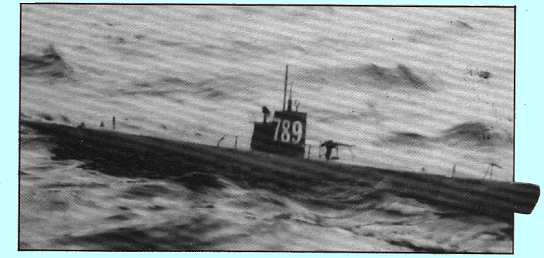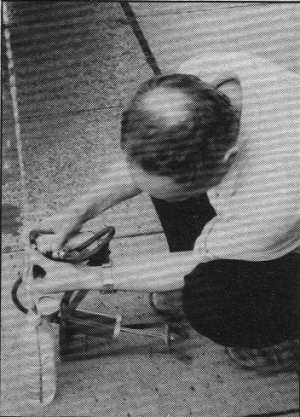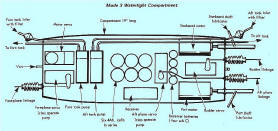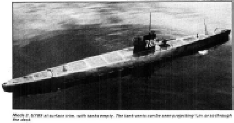|
U789
Part 3 - Kapitan Bill Thomas
|
|
Kapitan Bill Thomas reveals all about successful model
submarine
construction and operation.
|
|

U789 in the 'chop'. Even in
moderately rough conditions, attempting to run submerged is a waste of
time, as the boat is impossible to see. But these boats enjoy such
conditions!
|
Investigating Blowing
Techniques
Full size submarines use compressed
air to expel water from their ballast tanks in order to rise to the
surface. I have heard of models using Freon gas or carbon dioxide, but I
discounted these as being too expensive and probably inconvenient,
Compressed air, however, was worth considering. I soldered a car tyre
valve into a small WD40 aerosol can (about 2in din x 6in. tall), and
pumped it up to 80lbs per square in. in easy stages, and with caution.
However it displayed no signs of distress. took an empty plastic
transparent turpentine bottle and fitted it with a vent tube and a longer
tube reaching right to the bottom, 3/16 ' in dia. copper. I connected the
aerosol to the turpentine bottle (capacity .75 litre, filled with water),
and pressed the valve, gently, hoping that water would he expelled from
the bottle in a nice orderly fashion. |
I was staggered and petrified by the ferocity of the jet which emerged!
It blasted all over the ceiling, and bounced back down again drenching
everything. My brain flashed a message to my index finger: "Release the
valve, stop the jet!" My index finger replied: "Who, me"", and all the
time the water was everywhere. I uttered a hoarse cry of dismay, and
hurled the apparatus into a corner. I then ran into the bedroom. "What's
going on'?" other members of the family shouted?" But I am master in my
own house, and I would not come out from under the bed. Later, I tried to
blame the dog, who was even more terrified than myself, but the state of
the ceiling gave me away. |
|

|
|
I'm not saying you can't use compressed air. The pressure I used was too
high, and the valve was not sensitive enough. After about three dives the
compressed air would rim out anyway, in the amounts I was contemplating. I
could later only use it as an emergency method of blowing a sunken model to the
surface. possible, operated by a timer.
|
So that was Mode 1. An undoubted success, being simple, requiring only
three channel gear and reliable. The disadvantages were, too high a speed
required to prevent its natural buoyancy raising it to the surface and
connected with this, a high current drain.
One evening at the lake, 1 had had my 25 minutes. the batteries had
indicated that they had had enough, and 1 was sitting gloomily surveying
U789 lying stopped at the waterside, and chewing anti depression
tablets. "Himmel", I said, "I've got to get more running
time out of this boat." I started fastening pieces of lead pipe to the
keel with elastic bands. Soon the boat was trimmed right down with the
decks awash. The gentlest of downward shoves with a finger-tip was
sufficient to send it right down. At first I thought it was going to stay
down, but she gradually floated up again. I set the planes to dive
position and gave a gentle push forwards. The boat went under with
scarcely a ripple. I hurried home and weighed the lead. 12oz. I cut
a piece of 1/2 in. square mild steel bar, abut 10in. long which turned out
to be about right and clipped it to the keel. Out came the hummingbird
motors and in went a couple of much smaller motors. they were not standard
Monoperms, but they were of similar dimensions and performance, made in
Germany, possibly an industrial equivalent of the Monoperms. I don't knew for sure.
They have proved ideal. when propelling the boat, the combined ampage they
pull only
1.8 amps. I added another D cell to the main pack, lifting the voltage to
7.2v, and fitted 30min dia. two blade brass props of my own manufacture.
The Tamiya speed controller was now redundant, and simple ahead stop
astern switching was used, with micro switches.
|
|
 |
Mode 2
The following Sunday 1 was at the lake early, with the heavily modified
U789, which I now regarded as being in Mode 2 operation, First I tried the
boat on the surface, without the steel bar on the keel. It was acceptable
I brought it in, and clipped the bar in place, then carefully deposited
the model in the water. It sank down until the deck was awash. I took a
quick swig of Phyllosan and started the motors. The result was pure magic.
It responded superbly, sliding gradually under the surface in the
deliberate way that the full sizers have. The response to the controls was
much better. |
More movement on the planes was needed,
and I could still improve on the balance, The endurance improved out of
all recognition. Now, the receiver batteries were getting exhausted before
the main batteries, after only 60 or 70 minutes as it happened. I1 thought
I had faulty batteries. I changed them. No better, still just 60 minutes
We were talking about it in the pub, and the point was made that the boat
was now spending almost all its time under the water and the hydroplanes
were in literally continuous use. The plane servos were giving the
receiver battery a bushing. I replaced them (they were normal pen cell
size) with Sub C cells The endurance of the boat rose higher again, now
over 2 1/2 hours, by which time I was exhausted, and the model was still
going strong. I did try running the radio gear off the main propulsion
pack, but the receiver wasn't having any of that, and I went back to the
Sub C's. |
|

|
If you find space at a premium in the
submarine, and wish to dispense with receiver batteries, a voltage
regulator can be used. Lieutenant M. Young uses one with complete success.
My own Rx dislikes the apparatus. however, and I still use a battery pack.
As we submarine commanders always say: "There is room for everything in
a submarine except a mistake." |
Though control was much better, there
was still a lot of room for improvement. What I needed was independently
controllable fore and aft planes. This meant 4 channel radio. I asked
around in the club, and no of the offers was a set of Digimax for £30. Old
gear, but top quality. None of 'yer paper circuit boards or pot tracks'.
Soon I had independent fore and aft planes. Progress was thrilling. Depth
keeping is never going to be dead easy, but viable control was now an
established fact, "We have the technology!" Practice with the system was
the order of the day. I soon tired of the iron bar on the keel, however,
and started to think about fitting tanks and pumps to achieve surface trim
and diving trim by radio. Mode 3 was just over the horizon. |
Questions
An integral part of the model submarining is the questioning.
These boats arouse far more than the normal interest shown by passers by
....
'Does it Dive?" is the favourite.
"Does it come up?" is a close second.
"Is it water proofs?"
"Why isn't it yellow like a proper submarine'?!."
"Did you know your boats just sunk. Mister?"
"How doesn't the water get in those slots?"
"Has it got a motor?" (they can see it moving along under the water)!
"Is it remote controlled?" '(you're standing there working the
transmitter)!!
"Can you make it torpedo that noisy boat?" (I wish I could)!!'
"Has it got an underwater camera?" (there is precisely nothing on the
bottom of the lake worth photographing!).
If you think these questions are gormless, you should hear some of my
answers!!!.
Now and again an intelligent kid, not always a boy, will follow you for a
while, and then ask a string of pretty good questions. These you answer
properly. My favourites are the seafarers, who know there is usually
something worth looking at on Tynemouth lake, and who stroll by now and
again. They know what to ask. When you've satisfied their curiosity, you
let the boat lie stopped on the surface, and get them talking. It's all
part of the enjoyment. |
Tactics
The Type IX family of U Boats were very successful. Relatively few were
built compared to the Type VII, as they were larger, and did not lend
themselves so readily to mass production. Of the six top scoring U-boats
of the war, three how ever were Type IX. They took longer to submerge, as
well, and were thus more vulnerable when on the receiving end of a sudden
radar guided aircraft attack which became increasingly common as Allied
.scientists started winning the electronic war, and when escort carriers
came on the scene. The long range Catalinas, Sunderlands, Liberators and
Wellingtons were also a source of fear to the U Bouts as the war
progressed. The U boat Command tried fitting additional anti aircraft
guns, and instead of diving and being hunted, they started staying on the
surface and slugging it cut with the aircraft. These fights were conducted
with extreme ferocity on both sides. and the outcome could not be
foretold. The aircraft were often large, low speed types, who came in
close to try for accurate attacks and did not present impossible targets.
Many were shot down.
On the surface. Type IX boats were also an awkward customer for a small
escort to tackle, such a., it Corvette. which with their speed of 18 1/2
knots they could out run in any case The deck guns they mounted, 88mm or
105mm were roughly equivalent to the 4inch guns of many, of the
escorts, and the
low lying sub did not offer much of a target. On the other hand. they
could not readily sustain much damage without serious effect. A four inch
hole in the pressure hull might be impossible to plug because of the maze
of pipe work and other gear which lined the inside of the boat. When forced
to the surface. U-boats did not frequently get the chance, to retaliate.
As soon as they appeared on the surface, probably damaged and shocked.
they were, attacked with a fusillade of gunfire of very calibre,
torpedoed, rocketed and rammed, such the fear and loathing they inspired
among the merchantmen and escort crews they attacked, and the U-boat crews
were usually gunned down long before they could
get to the deck gun. Most Type IX U Boats lived and died violently, often
in remote parts of the world by virtue of their long range of about 12,500
miles.
Only one still exists, as far as I know. The story of its capture by a
U.S. hunting group is told in 'Clear the Decks', by Admiral D. Gallery who
commanded the force, the centre of which was the carrier 'Guadalcanal', I
recommend it as a very readable book indeed. The U-boat, is in it museum
in Chicago. and when I win my fortune on the football pools, I in heading
for Chicago in rapid order, because I would dearly like to see that boat.
That is. if I can get through US, Customs. Maybe they'll think I'm an
Undesirable Alien! If they read this, I wouldn't blame them.

http://www.msichicago.org/exhibit/U505/U505home.html |
Three Dimensions
The orthodox boat modeller accustomed to two dimensional control, is
almost certain to find the use of a third function awkward in the initial
stages, as I did. I became intrigued with the problems associated with up
and down control to the extent that I constructed a model aircraft and
learned how to fly it. The experience is helping me to obtain better
control of the submarine. One habit I have picked up from aeromodellers is
worth mentioning. They continually check the condition and functioning
of their models. Not just a quick look now and again, but frequently,
to an extent that I have never observed boat modellers to use. It's a good
habit, and one that I have got into, and on two occasions it has saved me
from acute embarrassment and irritation with U789! |
The first milestone in the careers of we U-boat Commanders is our first
submerged trip of 2 or 3 yards. When you achieve this feat, you may apply
to me for your Certificate. On receiving it, you will be officially
entitled to place the letters B.Sc. after your name (British
Submarine Captain). The whole thing is done "in the best possible
taste!" In addition. you in are entitled, here it says on your Tax Form
'state Your occupation', to put 'U Boat Commander'. Of course. if your tax
man, its is likely, is ex Royal Navy ", and served on Corvettes in the,
Atlantic 1939-45, you might well run into difficulties with your taxes
over the next year or so, but doubtless this is a risk you will be glad to
take. ( NB. To cover administrative expenses and overheads, your
application for your Certificate should be accompanied by a substantial
remittance' There is no need to prove your achievement. just send the
money. I really mean that most sincerely.) |
Dive! Dive! Dive!
When attacked on the surface, U Boats were desirous of disappearing
as rapidly as possible. In addition to flooding the tanks and applying
dive to the hydroplanes, they used a third expedient. All crew members not
actually manning the controls would rush to the, fore end (or 'bow' as we
experts call it). the diesels would thunder at full bore until the water
was about to pour down the hatch, at which point, the diesels would be
shut off, the hatch slammed shut and the electric motors cut in. If the
timing was not quite right, either a large amount of water entered the
boat, or a large amount of air was sucked out by the diesels, with painful
results. to eardrums, etc. |
Once a submarine was forced to dive, it lost most of its performance,
being dependant on batteries for propulsion. A typical limit was 80
miles at about normal walking pace, or maximum speed submerged, about 8 to
9 knots, which could only he sustained for a matter of about two hours.
Schnorkels were devised, basically v breathing tubes projecting above the
surface which enabled the diesels to run with the boat under water, at
periscope depth. Speeds of 6 knots were about the limit. In rough
conditions, a cut off valve prevented water getting down the trunk of the
schnorkel. and also air, which made the method very uncomfortable for the
crew. because the diesels sucked in air regardless, causing severe
variations in the air pressure inside the boat. |
Without the schnorkel, submerged endurances of more than 1,5 hours became
unhealthy, as oxygen was consumed and carbon dioxide emitted by the crew
With the severe condensation and humidity, oily fumes from the engine
room, emissions from the vast lead acid batteries, rind the odour from
bodies which could not be washed for weeks at a time, the interiors of
submarines were a horrendous environment for the human system. Toilet
facilities must have been nightmarish, There were two on Type IX boats,
for a crew of 50 to 55 men. However, one was almost invariably used as a
store, as was every possible nook and cranny in a small boat already
infested with machinery, pipes and equipment of every type |
To operate the flushing system was not simply
a matter of pulling a chain. A sequence of valve operations, involving the
use of high pressure air. was required, and if not performed correctly a
geyser of unspeakable material would deluge the entire compartment and its
luckless occupant. The apparatus could not be used below a depth of about
200ft. or when the boat was under attack. in which case buckets were used.
The effect of these in an already hideous atmosphere can only be imagined.
The interiors of these submarines were not lovely places. They were bad
enough during normal running. When they were being depth charged it must
have been pure undiluted hell. It took a special breed of man to be a
submariner, to withstand the cloister, phobia, the boredom, and the fear.
The amazing fact is that there was no shortage of volunteers for submarine
service in any of the navies of the nations involved in the conflict. In
round figures, the Germans for example. built 1,100 U boats, of which they
lost 780 (They sank 2.500 ships), Yet at the closing stages of the war,
their morale was still high |
|

|
Mode 3
Loafing around in the model shop, my beady little eyes latched on to some
M.F.A. pumps, as used for pumping glow fuel in and out of tanks. I bought
one and hurried home. On 7 volts, it emptied my turpentine bottle in rapid
order, pulling .8 of an amp. It is a good product, no piston or cylinder,
just a couple of gearwheels. a-la car oil pump. Next, came the
installation of ballast tanks in U789. I ascertained the approximate size
by experiment, and fitted the tanks. The ends were of 20swg aluminium. the
tops transparent acrylic sheet. I needed to know m hat was going on in
those tanks. The aft tank required two tunnels for the plane and rudder
rods. and these were of 1/2in. aluminium tube. The adhesive was Stabilit
Express. The tank tops had two circular hatches, tin. diameter, and the
vent tubes were fitted to these. I purposely made the tanks oversize. |
|

|
Experiments started in the bath It took 1 1/2 minutes to fill both tanks,
rather a long time. Worse, the tanks did not fill evenly. One always
filled first, then vented, with the other half full. I fitted restrictors
and valves into the quicker filling tank, but it wouldn't come right.
Sobbing miserably, I went back to the model shop and bought a second pump,
This transformed the situation. I could now fill the tanks in 4,5 seconds,
and I could balance the boat at will. When the required diving trim was
reached, i.e. with the deck awash, there was, as expected still air
remaining in each tank. This would have been bad news if allowed to
remain, because when the boat submerged, that air would be compressed. and
more water would enter the tank thus altering the trim. Control is oil
difficult enough without trim alterations happening Thus, corks mere
inserted through the 1in hatches mentioned above until the airspaces were
completely removed. "Da ist gut. Bill!" I said to myself completely
feeling that I had now licked the trimming problem - wrong again! |
|

|
I had failed to take water temperature into account, In warm water, the
boat will lie deeper. This is worth remembering when you are
experimenting. In colder water the boat will be reluctant to dive. To
overcome this. I planted a vertical a1/8in diameter brass rod in each of
the free flooding spaces, fore and aft. I made a couple of dozen in
diameter discs of 3/16in. thick sheet lead, with ,a 5/8 in, hole in the
centre These little weights could be dropped on to the rods or easily
removed with a little wire looped gadget, and they served in, the final
adjustment of the trim. The job could have been done rather more smoothly
by admitting further water to the boat, but like many 'lashups', this
little disc system works well enough. |
The MFA pumps have proved to be robust and reliable, but they must be
protected led by filters. It is net fair to expect gear type pumps to
digest water containing grit, sand and other foreign material. Each pump
should be protected by an easily accessible filter at both inlet and
outlet, l e two filters per pump, of the type (in line) used fly i/c
engine modellers to filter their fuel |
I have heard yarns about model submarines using bicycle pumps to
pressurise their boats. Fair enough, but it is rather like using a
sledgehammer to knock a tintack in. If you blow down the silicone tube
vent, fairly hard. then plug the end, with the tube nipped between finger
and thumb, you will have all the pressure in the boat you need. U789,
without wishing to tempt providence, is far dryer than the flatties (multi
speed boats) I have been racing over the years. But keep checking for
leaks, especially after you have been rimmed. These low-profile submarines
blend into the background too well for their own safety, and other
modellers, perhaps with poor vision or not vigilant will occasionally
clatter into your submarine. until you learn the arts and craft, of like
experts such as myself!
|
|
Back to U 789 index
Home
|